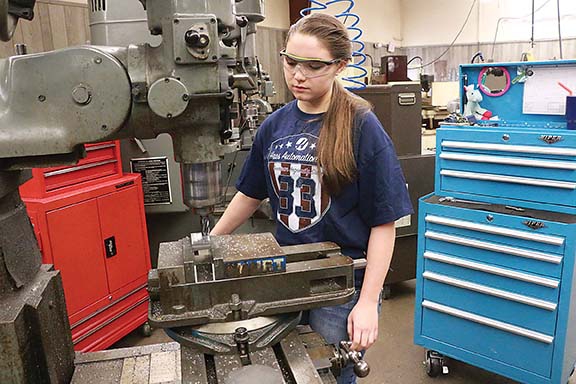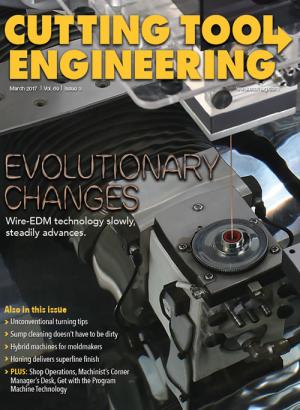Jennifer Creamer, a Ph.D. student in mechanical engineering at Missouri University of Science and Technology (Missouri S&T), conducts research into fixing flaws introduced when machining large components. Several different approaches exist to help compensate for those errors, but none of them provides a complete picture, according to Creamer.
Manufacturers must combine various methods to get the best sense of a milling problem. The result, she wrote, is “a piecemeal approach that makes calibration a time-consuming and expensive process.”

Maci Key is newly enrolled in a machine tool technology program
at Wallace State Community College. Image courtesy of WSCC
Creamer set out to find a way to eliminate that piecemeal approach and develop a new model for capturing complicated geometric errors while automatically generating compensation tables for those errors.
Beyond her research, Creamer herself is worthy of attention in this era of concern about manufacturing jobs going unfilled because of a lack of interested or qualified candidates. She’s female—still an underrepresented group in manufacturing—and she’s chosen to go into manufacturing by way of Missouri S&T.
It turns out Missouri S&T has had a lot of experience in attracting people to its programs. In 2016, the institution celebrated its centennial anniversary. Its Department of Mechanical and Aerospace Engineering is home to more than 1,100 undergraduate and graduate students and 40 full-time faculty, making it the largest academic unit at the university.
On the other extreme of size and age is the Tennessee College of Applied Technology (TCAT), which will begin a machine tool technology program this year, with classes slated to begin this spring. The 16-month program allows students to learn basic machine tool operations and get hands-on experience with a variety of machine tools. The program was established, at least in part, in response to a request from local manufacturers who want better-trained and more-qualified workers, according to one of its instructors. The school also hopes that the program encourages more manufacturers to invest in the area.
Just how many U.S. machining education programs there are is difficult to ascertain. The not-for-profit College Board organization’s website (www.collegeboard.org) lists 180 schools that offer a major in machine tool technology. Two-year schools make up 172 of that number. Campus Explorer lists 248 schools—including vocational and graduate schools—with machine tool technology programs in its database.
Could the new program at TCAT signal that the number of programs is growing? If so, these schools will find themselves having to compete more than ever to fulfill their enrollment goals. They may find they need to continue to reach out to women and other underrepresented groups in the field—as has Wallace State Community College, Hanceville, Ala., which reports that women are thriving and enjoying traditionally male-dominated fields such as machining.
Related Glossary Terms
- calibration
calibration
Checking measuring instruments and devices against a master set to ensure that, over time, they have remained dimensionally stable and nominally accurate.
- gang cutting ( milling)
gang cutting ( milling)
Machining with several cutters mounted on a single arbor, generally for simultaneous cutting.
- milling
milling
Machining operation in which metal or other material is removed by applying power to a rotating cutter. In vertical milling, the cutting tool is mounted vertically on the spindle. In horizontal milling, the cutting tool is mounted horizontally, either directly on the spindle or on an arbor. Horizontal milling is further broken down into conventional milling, where the cutter rotates opposite the direction of feed, or “up” into the workpiece; and climb milling, where the cutter rotates in the direction of feed, or “down” into the workpiece. Milling operations include plane or surface milling, endmilling, facemilling, angle milling, form milling and profiling.


